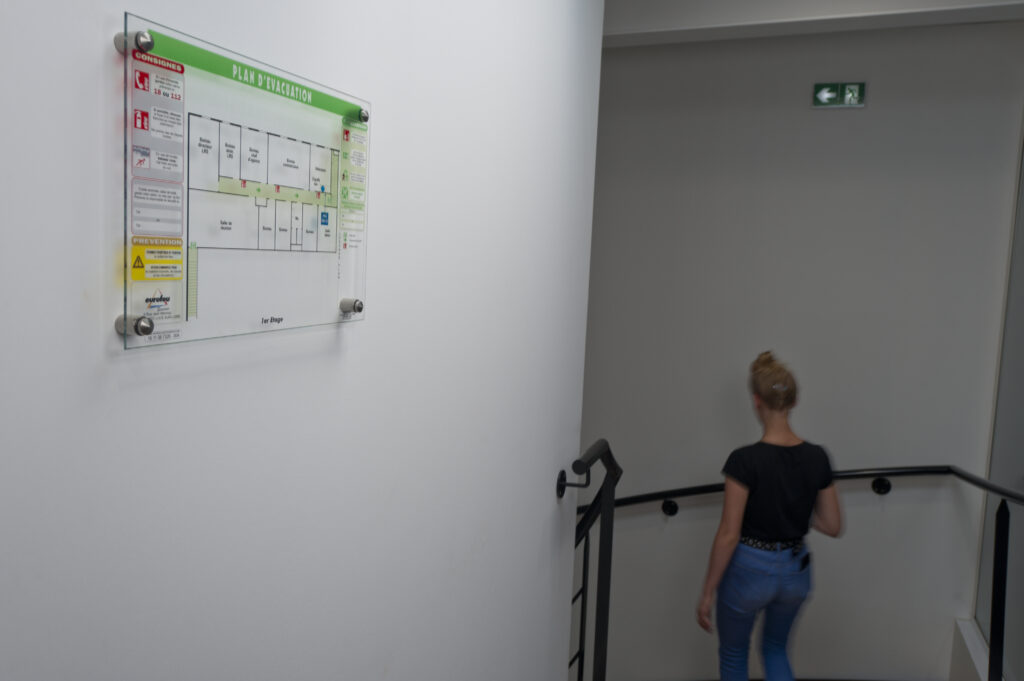What are the evacuation procedures?

When faced with an emergency such as a company fire, everyone's safety depends on an efficient, orderly evacuation. This requires a precise plan, clear instructions and regular drills. The aim is to familiarize staff with evacuation systems and ensure a safe exit. So how do you give the right order, and what should you do in the event of fire? We invite you to discover the essential evacuation procedures.
Understanding evacuation procedures
Importance of evacuation procedures
Evacuation procedures play a fundamental role in keeping people safe in the event of an emergency. They not only guide people to safe areas, but also reduce the risk of confusion and panic.
To be effective, an evacuation procedure must include several essential elements:
- Designation of trained evacuation team members
- Organizing clearly identified assembly points
- Clear, accessible evacuation plans
On an industrial site, for example, it is crucial to know the emergency exits and to carry out regular drills to optimize reaction time. Good communication, with clear instructions and an appropriate audible or visual signal, is also essential to coordinate an orderly evacuation.
This preserves life and ensures rapid, unhindered evacuation.
Purpose of evacuation procedures
Evacuation procedures are primarily designed to ensure the safety of all occupants in an emergency situation. They enable rapid exit from buildings, while minimizing the risk of panic. To achieve this objective, several elements must be put in place:
- Ongoing training to familiarize staff with actions to be taken
- Clearly signposted emergency exits and assembly points
- Regular drills to test and improve evacuation efficiency
A concrete example would be a company that organizes fire drills twice a year. During these drills, employees learn how to use fire extinguishers correctly and how to follow instructions on how to get to emergency exits. These actions reinforce good reflexes and ensure that everyone knows what to do in the event of a real emergency.
Who is affected by evacuation procedures?
Evacuation procedures concern all building occupants, whether employees, visitors or customers. Everyone must be informed of safety instructions and evacuation routes. Employees, in particular, are obliged to be familiar with the procedures and to participate actively in regular drills.
Disabled people requiring special assistance must be taken into account in these plans. Evacuation team members can be appointed to accompany them in complete safety. In a company, for example, safety managers ensure that exits are clear and accessible to all.
It's essential that everyone knows how to react quickly and calmly to a fire alarm, to ensure a safe and efficient evacuation. Regular drills help reinforce this knowledge and ensure that everyone is prepared in the event of an emergency.
Setting up evacuation procedures
For effective evacuation procedures, several steps are necessary. First, it's crucial to draw up a clear evacuation plan, identifying exit routes and assembly points. These elements must be clearly marked so that they are visible in the event of an emergency.
Next, it's essential to train staff in the procedures to be followed during evacuation. Training should include practical exercises to familiarize everyone with the process. These exercises should be carried out regularly to improve reflexes and organization.
It is also advisable to appoint evacuation leaders to guide occupants. These people will be responsible for ensuring that everyone leaves the premises safely.
Finally, it is important to review and update procedures regularly to ensure that they remain adapted to any changes in the working environment.
Key elements of evacuation procedures
The evacuation plan
For an effective evacuation plan, there are several essential elements to consider. First and foremost, evacuation routes must be accurately mapped. These paths must be clearly marked and unobstructed to guarantee a rapid and safe exit.
Another aspect to consider is the location of assembly points. These secure areas enable the presence of all occupants to be verified after evacuation. It's also crucial to ensure that safety equipment, such as fire extinguishers and alarms, are accessible and functional.
Here are some key elements to include in your plan:
- Emergency exit signs
- Appointing evacuation managers
- Regular drills to familiarize staff with the plan
These measures help minimize risks and ensure an orderly evacuation.
The correct evacuation order
During an evacuation, the order of exit must be carefully planned to ensure everyone's safety. Prioritize the most vulnerable people, such as the disabled, children and pregnant women. It is essential that these groups are accompanied by trained team members.
Next, employees with specific responsibilities, such as guides and trail grips, must follow. Their job is to direct others to the exits and make sure no one is left behind.
Finally, the other occupants can evacuate. To avoid traffic jams, we recommend keeping to an orderly flow and following designated routes.
Make sure evacuation routes are well marked and clear. Coordination and compliance with instructions are crucial to a successful and rapid evacuation.
Evacuation instructions
To ensure an orderly evacuation, clear instructions must be communicated to all occupants. These instructions include the actions to be taken as soon as an alarm sounds. It's vital that everyone knows where the emergency exits and assembly points are.
The instructions must also specify the specific responsibilities of certain personnel, such as the role of the guide-files and guide-grips, who are responsible for directing and securing movements. These teams must ensure that no one is left behind.
In the event of dense smoke when evacuating, it is advisable to move to a low position to avoid inhalation. Doors should be closed behind you to limit the spread of fire.
Instructions are prominently displayed and must be regularly reviewed to ensure they remain effective and up to date, guaranteeing everyone's safety.
Sample fire evacuation procedure
Identification of fire-specific audible and visual signals
In the event of a fire, a distinctive audible signal warns occupants to evacuate the premises. This sound, which complies with standard NF S 32-001, must be recognized by all. It is often accompanied by visual signals, such as flashes of light, to ensure that the alert is perceived even in noisy environments or by hearing-impaired people.
Here are the characteristics to take into account to ensure effective alerting:
- Loud signal: must be audible throughout the building, exceeding ambient noise by at least 10 dB.
- Clear visual signals: flashing lights or evacuation signs can help guide occupants to the exits.
These devices are essential for rapid and safe evacuation, ensuring that no-one misses the alert, wherever they are in the building.
Evacuating premises: how does it work?
When evacuating premises in the event of fire, a number of steps are essential to ensure everyone's safety. As soon as the alarm sounds, each person must head for the nearest exit, following the evacuation paths indicated beforehand. Emergency exits must be kept clear and accessible at all times.
Effective coordination is essential. The role of the guides is to direct the movement of people and ensure that no one is left behind. They check that everyone reaches the assembly point safely.
To optimize evacuation, it is crucial to follow certain instructions:
- Do not use elevators
- Bending down in case of smoke
- Close doors behind you without locking them
These measures guarantee rapid and safe evacuation, minimizing the risks associated with fire.
The role of the guide-files and bookends
Guides and clerks play an essential role during an evacuation. Trained in safety rules, they coordinate movements to avoid panic. The guide is at the head of the group, directing people to the nearest emergency exit.
As for the fire warden, he or she ensures that no one is left behind, checking unoccupied rooms and closing doors to limit the spread of flames. These roles require in-depth knowledge of the premises and evacuation routes.
They also need to know how to handle emergency situations, especially if people need special assistance. Their mission is to ensure everyone's safety all the way to the assembly point.
Concrete examples: in the event of a fire, the guide can calmly inform evacuees of the steps to follow, while the line-keeper moves up the queue to check that everyone is following correctly.
Managing an emergency evacuation in the workplace
On-site evacuation preparation
To ensure effective evacuation preparedness, a number of factors need to be taken into account. First and foremost, regular training for all personnel is crucial. This training should include evacuation simulations so that everyone can acquire the right reflexes.
Next, it's important to appoint evacuation managers. These people must be trained to coordinate movements and deal with unforeseen events.
The evacuation plan must be clearly displayed on every floor, and evacuation routes must be clear and easily accessible.
Finally, a safe assembly point must be defined outside the building. Employees need to know how to get to this point safely. Clear and regular communication on these procedures is essential to ensure everyone's safety.
Responding to emergencies in the workplace
To respond effectively to a corporate emergency, a number of factors need to be taken into account. Regular employee training is essential. This includes knowledge of safety instructions and practical exercises.
It is essential to designate clearly identified persons in charge. They must be trained to deal with evacuations and unforeseen events. Internal communication also plays a crucial role. It enables the necessary information to be transmitted rapidly to all levels.
Safety equipment, such as fire extinguishers and alarm systems, must be regularly checked and easily accessible. Preventive measures also include making installations safe, such as shutting down ventilation systems or gas supplies.
Finally, don't underestimate the importance of assembly points, which must be known to everyone. These steps guarantee a coordinated and safe evacuation, minimizing risks to occupants.
The role of company safety officers during an evacuation
Safety managers play a vital role in managing company evacuations. Their mission includes several essential tasks to ensure everyone's protection:
- Team coordination: They supervise the guides and guides, ensuring that each member knows exactly what to do.
- Communication: They must give clear, precise instructions to occupants to avoid any confusion.
- Dealing with the unexpected: When problems arise, they make quick decisions to adapt to the situation.
- Installation checks: They ensure that emergency exits are unobstructed and that safety equipment is in working order.
A concrete example would be the use of walkie-talkies to keep in touch with team members during an evacuation. These responsibilities, crucial to the smooth running of operations, ensure that all occupants reach the assembly point safely.
Mistakes to avoid when carrying out evacuation procedures
When carrying out evacuation procedures, certain mistakes can compromise the efficiency and safety of everyone involved. Here are some common mistakes to avoid:
- Forgetting to clearly mark emergency exits. This can confuse occupants, especially in large buildings.
- Use complex instructions that take too long to understand. In emergency situations, simplicity and clarity are essential.
- Neglecting regular evacuation drills. These simulations reinforce reflexes and help identify areas for improvement.
- Block escape routes with objects. Always keep corridors and stairways clear to allow free flow of traffic.
- Failure to train evacuation managers sufficiently. They need to be able to deal with the unexpected and guide people to the exit.
Avoiding these errors contributes to safer, faster evacuation.


